




| Home | Features | Club Nights | Underwater Pics | Feedback | Non-Celebrity Diver | Events | 25 April 2024 |
| Blog | Archive | Medical FAQs | Competitions | Travel Offers | The Crew | Contact Us | MDC | LDC |

|

|
 
 |
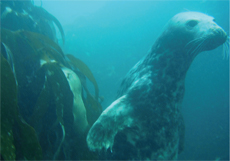 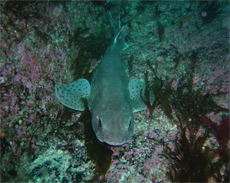 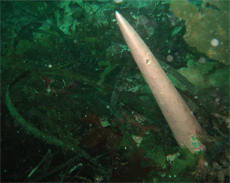 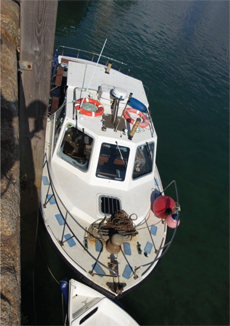 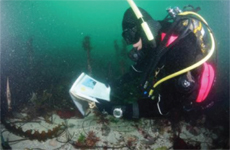 ISSUE 21 ARCHIVE - SCILLY DIVINGLouise WallaceIf you have been to the Scillies, you may have enjoyed the solitude, the green scenery of the tiny islands and epic expanses of sub-tropical style glistening white sand beaches and azure blue seas, served by friendly locals all too dependent on tourism as the almost sole income. Some, of an earlier generation, may remember TV news of Harold Wilson, Prime Minister, on his holidays, and know that he is buried there.Of all the many islands and groups of islands around Great Britain, none of equal size or population is as exposed or remote as the Isles of Scilly. What you probably don't know, is the Islands have as much history below as above sea-level, including ancient burial grounds from thousands of years ago, and Napoleonic forts with original gun emplacements intact. These islands are the remains of ancient sunken volcanic mountains that now exist at the junction of the major shipping lanes of the Irish Sea, English and Bristol Channels. Because of navigational error and often made worse by fog, it has the largest concentration of wrecks in the world, with over 1,000 named and mapped, and that cannot be all! So, it was with curiosity that I joined my first dive trip there with Severnside Sub Aqua in 2008. And I have organised my own trips every two years since for Banbury Sub Aqua. The boat gets booked over a year in advance so all 12 diving places are reserved by word of mouth from previous trips in our club. There are only two dive boats operating a short Summer season. We dive with the best (and only female) skipper and diver I have ever met, Jolene Williams, a native of the islands brought up to the job by her father on St Martin's island, where there was one teacher to 3 children in the local primary school. We stay in various B and Bs or rented accommodation on St Mary's, the largest of the 5 inhabited islands. We get to and from the islands with all our dive kit including tanks, weights and any spares, on the Scillonian, the only ferry out from Penzance which takes nearly 3 hours to do the 42 miles. We often see basking shark en route. This year's trip was as good as any I have done, with the added excitement of taking divers to waterin ways they had not bargained for! The weather was balmy- and so were the divers! With so much sun and minimal wind, we got to dive the sites we chose, with a weather eye on sea state from Jolene. Day one was a warm up dive on Wingletang Ledge off St Agnes, a lovely wall covered i n Jewel anemones. Having got settled we were ready for wreck hunting, and dived the wreck of the Delaware which sank off a now uninhabited island of Samson in December 1871. This is associated with a heroic rescue by islanders from nearby Bryher. They were gig sailors who manhandled their heavy wooden lifeboats (gigs) over a steep hill to rescue them in heavy seas, only to be greeted by two sailors who were terrified and threw stones at them in defence! The wreck was huge and full of life, with lots to explore for divers with and without wreck experience. Next day was my favourite choice which is The Eagle. It is a historic wreck (sister ship of the Firebrand- later), on Tearing Ledges at the foot of Bishop's Rock Lighthouse. This lighthouse is the farthest point of the UK before America! It has loads of huge cannon and anchors over 12ft long on the seabed. The Eagle went down along with three other Men of War in 1707, and the Admiral Sir Clowdisley-Shovell with 1450 sailors perished. No dead people were associated with Trenemene Reef Wall, Western Isles, a find your depth dive and jewel anemones in dazzling carpets of colour. Next day we had two for the price of one. The Hathor (1920), a big steamship, sank across the wreck of the smaller Plympton, which sunk in 1909. Both are off St Agnes island, so one wreck sits crossways over another. These are magnificent and worth a revisit. Then we dived the Italia, a huge wreck off St Agnes. This went down in 1917, the same day as the Lady Charlotte (later). On Day 4 we dived the bow of the most recent Scilly wreck (the Cita). This was a huge container ship that grounded in 1997 at 20 knots as the sailor in charge was asleep and all alarms tuned off as it went full speed ahead into the rocks of St Mary's. It lies right under the flight path of the light aircraft that land on St. Mary's. This wreck made the fortunes of many islanders. For some reason the coastguard were undermanned and a huge amount of contraband (designer clothes, car tyres, gas cylinders) found its way into islanders' homes. The wreck is huge and takes two dives to do the now separated stern and bow. Next was the long anticipated seal dive off St Martin's island, (a small outcrop called Menawathen). Seals have to be courted, as wild animals, on their own terms. They are large, and could land a nasty bite if mistreated, and they simply won't play unless they want to. At first they would not play. We watched them lolling about on the rocks in the sun. As the tide comes up, they tend to lose their sun warmed rocks, and fall in for a swim if they want to. Banking on this we buddied up and dived into a depth of about 2-6 metres. We had a fairly dull 40 minutes in four metres. Then, a grey form appeared. It was a shy pup, just checking us out. Minutes later we were joined by a succession of its buddies. We felt a tug on the SMB. Thinking the skipper was impatient for us to end the dive we looked up. We then saw several of them playing a kind of "lets sink the balloon trick" by rolling on it and biting it! We carried on diving with seals above and below us for what became a 75 minutes dive to remember. Day 5 was historic wreck day, and I don't mean our oldest member! We dived the Firebrand, one of Sir Clowdisley-Shovell's 4 wooden warships lost on the way back from the Nile in 1707. Its timbers have been sunk in mud for many years but sea action exposes them, and they rot fast leaving only the metal to be exposed and rust much more slowly. This had cannon, cannon balls and a newly uncovered musket. We were told, look don't touch. A curious dog fish paid us a call. Later on when exploring the island we found the memorial to this revered admiral. The story was that he was washed ashore some days later and local Scilly. Next up was the Colossus. This went down on Southard Well, south of Samson Island in 1798 and was discovered about 20 years ago, and marked out with a set of flags and guides. The wooden side is part exposed with gun ports, the breach end of the cannon sticking up, and copper pins that held the planks sticking up from the sand which are bright green/silver colour and very sharp. There is a wet proof map we took down with us to help us see what we were looking at. The back ends of cannon stick up out of the sand, which is quite eerie, as the boat is effectively on its side and we are viewing it from inside the boat where the cannon were loaded, but with only one side still existing. The magnificent carved prow is preserved, along with other prows of wrecks of the Scillies in "Valhalla" a museum on Tresco. The last day was King Coal. The Lady Charlotte that went down the same days as the Italia in 1917 in Porth Hellick St Mary's, and in the afternoon we dived another Coal ship, the King Cadwallon. This was a huge paddle steamer ship off St Martin's. The last dive showed how beautifully encrusted a wreck can be, with all the coloured plumose and jewel anemones, as well as large fish such a wrasse and whiting. Nudibrachs were spotted by most of us, then identified by our keen BSAC specialist course trained diver pair. Above ground, we were based on the largest island – St Mary's. We ate at some incredible restaurants, and had a lot of local and other ales. One pub did over 30 ciders. I just need another week here to sample them all. Islands visited each afternoon after diving was over included Bryher, Tresco, St Agnes and St Martin's. On Tresco there are two castles, one for the Royalists, one for the Round heads. Cromwell's castle is my favourite. This trip had a new highlight. In our club there is a diving couple, where the wife enjoys diving but sneakily wants her husband to enjoy riding too. So we had a riding trip for several nubbies to get into water on horses. This proved great fun for us all, though I am told no new riders were converted by the experience! We will be back again in 2016, there is just so much to see, eat, drink and enjoy! |